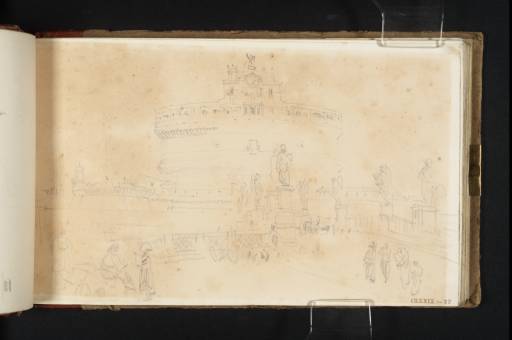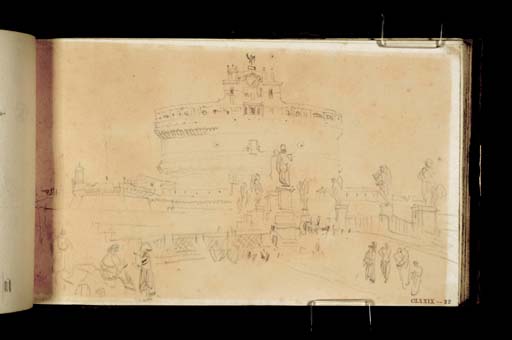Joseph Mallord William Turner Castel Sant'Angelo, Rome, from the Ponte Sant'Angelo 1819
Image 1 of 2
Joseph Mallord William Turner,
Castel Sant'Angelo, Rome, from the Ponte Sant'Angelo
1819
Joseph Mallord William Turner 1775–1851
Folio 22 Recto:
Castel Sant’Angelo, Rome, from the Ponte Sant’Angelo 1819
D14967
Turner Bequest CLXXIX 22
Turner Bequest CLXXIX 22
Pencil on white wove paper, 112 x 186 mm
Stamped in black ‘CLXXIX 21’ bottom right
Accepted by the nation as part of the Turner Bequest 1856
Exhibition history
1869
Second Loan Collection selected from the Turner Bequest, various venues and dates, 1869–1931 (no catalogue but numbered 122a).
References
1909
A.J. Finberg, A Complete Inventory of the Drawings of the Turner Bequest, London 1909, vol.I, p.527 as ‘Castle of St. Angelo. No.122a, Second Loan Collection’.
1987
Robert E. McVaugh, ‘Turner and Rome, Raphael and the Fornarina’, Studies in Romanticism, no.26, Autumn 1987, p.372.
1991
Ian Warrell, ‘R.N. Wornum and the First Three Loan Collections: A History of the Early Displays of the Turner Bequest Outside London’, Turner Studies, Summer 1991, vol.11, no.1, p.45, no.122a.
The vast size, striking shape and prominent location of the Castel Sant’Angelo, located on the banks of the Tiber near St Peter’s and the Vatican, make the castle one of the most prominent landmarks in Rome. Originally the mausoleum of the Emperor Hadrian, the cylindrical building dates from AD 139 but was later converted from a tomb to a fortress, acting as part of the military defenses of the city until the end of the nineteenth century. The name derives from a legendary vision of the Archangel Michael who reportedly appeared above the building sheathing his sword as a symbol of the end of a great plague in 590 AD. Since 1753, a massive bronze statue of the angel by the Flemish sculptor Peter Anton Verschaeffelt (1710–93) has crowned the top, replacing an earlier one in marble by Raffaelo da Montelupo (circa 1504/5–circa 1566/7). The castle is linked across the Tiber to the centre of the city by the Ponte Sant’Angelo, a bridge built by Hadrian and formerly known as the Pons Aelius.
Turner’s sketch depicts the Castel Sant’Angelo from the opposite bank of the river, near to the southern end of the Ponte Sant’Angelo. Visible in the foreground are a number of human figures, dwarfed in size by the large sculptures of angels by Gian Lorenzo Bernini (1598–1680) which adorn the bridge. Further views of the Castel Sant’Angelo can be found on folios 23 and 26 verso (D14968 and D14973), as well as in the St Peter’s sketchbook (Tate D16215 and D16216; Turner Bequest CLXXXVIII 33a and 34); the Rome: C. Studies sketchbook (Tate D16336 and D16358; Turner Bequest CLXXXIX 10 and 32); and the Small Roman C. Studies sketchbook (Tate D16405; Turner Bequest CXC 9). The castle also formed the subject for two vignette watercolour illustrations related to literary projects: Rome, Castle of St. Angelo for Rogers’s Italy, circa 1826–7 (see Tate D27677; Turner Bequest CCLXXX 160); and The Castle of St. Angelo for Byron’s Life and Works, circa 1832 (Tate, N05243).
This page was selected by Ralph Nicholson Wornum for the Second Loan Collection, a group of sixty-two works exhibited in the provinces during the late nineteenth and early twentieth centuries.1 It was removed from the sketchbook and displayed within a mount. Consequently, like the other works included in those tours, the drawing has suffered badly from over-exposure to light and the paper has yellowed considerably.
Verso:
Blank
Inscribed by an unknown hand in pencil ‘?22 | CLXXIX | [?47]’ bottom left
Blank
Inscribed by an unknown hand in pencil ‘?22 | CLXXIX | [?47]’ bottom left
Nicola Moorby
January 2010
How to cite
Nicola Moorby, ‘Castel Sant’Angelo, Rome, from the Ponte Sant’Angelo 1819 by Joseph Mallord William Turner’, catalogue entry, January 2010, in David Blayney Brown (ed.), J.M.W. Turner: Sketchbooks, Drawings and Watercolours, Tate Research Publication, December 2012, https://www


